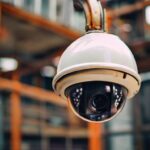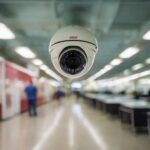The need for video surveillance and security camera systems in retail stores and small businesses has risen sharply in recent years. Shoplifting, organized retail crime, and employee theft are major issues impacting revenues. Security cameras for stores help provide protection from the obvious, and less obvious risks to any retail business.
Retail Theft and Other Risks
Retail theft in stores has steadily increased over the past decade as economic pressures and organized retail crime networks have grown. Shoplifters and dishonest employees now make use of advanced techniques to steal merchandise and cash. Many business owners have realized that having a security camera system in place is crucial.
Statistics on Retail Crime and Theft
- Shoplifting now accounts for over $50 billion in retail losses annually according to the National Retail Federation
- On average, 1 in 11 people steal merchandise from stores. Source: National Association for Shoplifting Prevention
- Employee theft accounts for an estimated 30% of retail shrinkage or $19 billion in losses annually
- Fake ID schemes, refund fraud, and loyalty program abuses result in billions more in retail losses
Benefits of Having a Security Camera System
Installing security cameras provides the following benefits:
- Deters potential thieves and criminals from targeting your location
- Allows for video evidence if thefts do occur to aid police investigations
- Protects customers and employees by monitoring safety issues
- Provides business analytics data by recording customer traffic patterns
Having cameras in place is a reliable way for retailers to minimize theft risks and protect their bottom line.
Choosing the Right Security Camera System
Camera Types
Fixed Cameras
Fixed security cameras are permanently positioned to monitor a certain area both indoors and outdoors. They cannot be moved remotely once installed. Fixed cameras provide continuous monitoring with no breaks in coverage, making them a key component in most security systems.
PTZ (Pan/Tilt/Zoom) Cameras
PTZ cameras can be remotely adjusted to change viewing direction and zoom-in on details like faces or license plates. PTZ cameras typically have high resolution with powerful optical zoom capabilities. Their versatility comes at higher costs compared to fixed cameras.
Dome Cameras
Dome security cameras have vandal-proof external housing making tampering difficult. Some dome cameras feature tinted lower halves to hide lens direction. These discretely designed units are used in many retail stores and banks to blend into ceilings.
Discreet/Covert Cameras
Discreet “spy cameras” are tiny cameras hidden inside ordinary objects like clock radios, smoke detectors, and phone chargers. They film secretly without easy detection. These types of hidden cameras can be highly useful but some states prohibit unauthorized filming in private areas.
Infrared/Night Vision Cameras
Infrared cameras have extra LEDs surrounding the lens to enable night time viewing in low ambient lighting conditions. The IR LEDs cast invisible light onto the scene. They capture clear black-and-white video without needing external illumination. These cameras are important for 24/7 monitoring both indoors and outdoors.
Image Quality
Resolution (HD, 4K)
Most modern indoor security cameras record at least high definition (HD) 1080p resolution while 4K ultra HD models are also available. Higher camera resolution equals more detail in the video footage but also larger storage requirements. HD is adequate for identifying faces and clothing colors in small retail stores while 4K excels at covering larger areas.
Frame Rate
The frame rate refers to how many images the camera captures per second, expressed in frames per second (FPS). Most security cameras operate at standard frame rates between 15 and 30 FPS. A higher frame rate like 60 FPS will provide smoother motion visualization for scenes with lots of movement. Consider a minimum of 25 FPS for a retail sales floor.
Wide Dynamic Range
Cameras with wide dynamic range (WDR) perform better in high-contrast lighting conditions. WDR helps balance shadows and blown-out bright spots. It brings out details that would otherwise be lost. Enable WDR for cameras aimed at store entrances and window displays that can have challenging mixes of indoor and outdoor lighting.
Features
Remote Viewing Capability
Look for security camera systems that enable remote access from mobile devices and web browsers. This allows business owners and managers to view live camera feeds from anywhere in real time. Remote connectivity also helps deliver a timely response if alarms occur during off hours.
Cloud Storage and Management
Storing camera recordings in the cloud spare retailers from having to maintain local storage hardware. It also enables seamless access from any internet-connected computer or device. Cloud camera systems offer different subscription tiers with varying lengths of event video retention.
Motion Sensors and Alerts
Motion detection features can send email or push notifications when a security camera senses movement within its field of view. Activity like customers walking past product shelves likely does not warrant alerts. But unusual motion when the store is closed at odd hours does.
Low Light Filming
Unless a store always has bright internal lighting, the security camera system should have low light capability. Color cameras shift to black-and-white infrared mode in dim conditions while keeping subjects visible. For 24/7 operation, cameras should film down to at least .1 lux light sensitivity.
Weather Resistance
Outdoor cameras safeguard building exteriors, loading docks, and parking lots. Models rated for weather resistance handle rain, snow, and temperature extremes through specialized housings and coatings. IP66 rating denotes dust-tight and high-pressure water jet protection.
Positioning Cameras and Coverage Considerations
Carefully planning security camera positioning within a retail store layout is crucial for maximizing coverage while minimizing blind spots that could hide theft activity. Proper infrastructure aids reliable camera connectivity and power delivery.
Store Layout Assessment
High Traffic Areas
Primary ingress and egress points see heavy customer activity daily. Queue lines during peak shopping hours may shield shady behaviours. Exit lanes need crystal clear observation to track merchandise leaving the premises.
Bottlenecks
Store choke points often create distractions as groups of shoppers converge then disperse. These high-density zones enable grab-and-run thefts. Spacing cameras to eliminate crowd coverage gaps limits this shoplifting method.
Blindspots
Carefully walk through the entire store footprint and parking lot to analyze sightlines. Make note of shelving configurations, displays, partitions, signage elements or other structures blocking views needed for security monitoring.
Lighting Issues
Brighter retail lighting deters crime while aiding video surveillance. Make sure shadowy corners and dim back hallways have adequate illumination for low-light cameras to work effectively. Consider adding extra lighting as needed.
Camera Positioning
Entrances and Exits
Position cameras directly above doors overlooking threshholds in centred alignments. Capture ingress shoppers and exiting parties head-on. Refer to height guidelines to avoid facial obstructions from hoodies or hats.
Point of Sale Areas
Watch cash wrap stations and self-checkout kiosks up close monitoring cashier and customer actions during transactions. Verify register drawers stay shut between uses. Confirm scans match items placed in bags.
Aisles
Span cameras down long aisles using higher mounting positions for wider fields of view. Select varifocal lens models with zoom capabilities. Capture subjects from top-down angles to see into baskets, carts and backpacks.
Inventory Storage Areas
Lockdown camera access to restricted employee zones like inventory prep areas, warehouses, loading docks and delivery bays. These sites have valuable goods worth stealing if insecure. Ensure full coverage without obstructed zones.
Employee Areas
While video monitoring employee-only sites sparks some controversy, unknown losses often emerge from these unseen spaces. Protect your business by filming break rooms, training areas, and back offices using disclosed cameras following local laws.
Networking and Infrastructure
POE Switches
Simplify infrastructure by connecting cameras over Ethernet via PoE (Power over Ethernet) switches. PoE passes both power and data over a single cable. It provides easy expandability accommodating additional future camera installations.
WiFi Coverage
When choosing wireless security cameras, walk test your retail space for WiFi signal strength. Stronger signals increase streaming reliability for stable remote viewing feeds. Strategically position additional access points to bolster coverage if needed.
Cable Runs
For wired cameras, neatly route extension cables through walls and ceilings back to a central equipment closet. Use conduit for a clean commercial aesthetic. Confirm adequate footage slack allowing repositioning flexibility. Label connections clearly at both ends for managed sanity.
Security Camera Data Management
Properly managing the video footage captured by retail security camera systems maintains evidentiary integrity and accessibility for authorized loss prevention staff. Both on-premises and cloud storage options provide scales of data retention capacity.
Local DVR Storage
Digital video recorders (DVRs) equip retailers with local data repositories saving camera streams to internal hard drives. DVR storage totals vary from a couple of terabytes for smaller systems up to tens of terabytes for expansive multi-site camera deployments. Match storage needs to the number of cameras based on resolution and frame rates.
Cloud Storage Plans
Alternatively, hosted cloud storage provides offsite data retention reducing local IT overhead. Leading video surveillance platforms offer customizable cloud backup tiers including:
Entry– Retains 7 days of event-based footage for basic coverage needs
Intermediate– Keeps 30 days of 24/7 continuous footage for many retailers
Enterprise– Offers 90+ days storage for customers requiring deep archives
Extended plans save years of historical video. Prices scale based on storage volume and retention duration. Based on average published industry rates.
Data Access and Monitoring
Grant authorized managers access to live feeds and recorded incidents via desktop dashboard portals or mobile apps. Privilege different access levels to supervisors versus standard employees. Monitor recent events daily for security anomalies or policy violations. Export and retain critical footage as needed for insurance claims or police reporting.
Security Camera Signage and Disclaimers
Importance of Signage
Prominently display warning signage making customers aware of video surveillance before entering stores and throughout premises. Signage acts as a theft deterrent while also establishing informed consent for legally monitoring public areas under most recording laws.
State and Local Regulations
Some jurisdictions enforce special regulations, permits or consent requirements concerning security camera installations and how/where recordings happen. Research laws applicable to your locale for compliance statutes covering both indoor and outdoor spaces.
Privacy Protections
Avoid filming spaces where customers and personnel expect reasonable privacy like changing rooms and restrooms. Disclose any employee-facing cameras in non-public sites per state statutes while adhering to company personnel policies. Protect sensitive recordings through strict access controls if scanning confidential documents or computer screens.
Installing a Security Camera System
Professional installation by qualified technicians ensures retail security camera systems function reliably meeting site-specific coverage and infrastructure needs. DIY installs works for simpler setups but bring greater risk, and should be avoided.
Professional Installation
Hiring experienced security integration firms to tackle the end-to-end installation process proves the wise choice for most brick-and-mortar store owners. Pros survey spaces, custom tailor camera counts and types for optimal visibility, securely mount units, efficiently run cabling, and complete backend programming configuration. They further test systems thoroughly and train staff on operation. Though pricier than DIY, professional installs deliver quality and performance.
Advanced Uses for Security Camera Footage
Business Analytics
In addition to security benefits, archived footage presents retail business analytics opportunities if reviewed more granularly. Owners can study customer shopping behaviors within store layouts guiding adjusted merchandising strategies. Traffic flow quantification by department aids staff scheduling. Returns and exchange incident video clips help identify problem source inventory.
Loss Prevention
Trained loss prevention analysts leverage recorded video in conjunction with POS data to combat “shrink” issues like shoplifting, fraud, and waste. Experts spot employee theft warning signs by observing cash wrap exchanges and backroom access. They cross-reference timestamps on suspicious activity with register and inventory system transactions, digging for root causes. Tighter control through footage audits minimizes retail losses.
Safety and Liability
Slip and fall accidents inevitably happen despite “wet floor” caution signs. Video footage containing clear incident imagery and documentation protects retailers from fraudulent or exaggerated injury claims. Cameras also improve premises safety by deterring criminal acts against customers and staff while aiding police investigations if violent events unfortunately occur.
Security Camera Maintenance Best Practices
Proactively maintaining security camera systems ensures uninterrupted recording performance, maximizes hardware lifespans, and aids integration with future platform upgrades.
System Health Monitoring
Check camera status indicators and access recent footage history daily. Verify adequate runtime battery levels for wireless units. Diagnose connectivity problems causing recording gaps. Routinely scrutinize imaging quality catching gradual declines from dirt/grime buildup.
Regular Footage Reviews
Assign staff to oversee weekly reviews sampling archived videos for integrity. Test search queries by date/time parameters across storage archives. Export sample loss prevention clips testing backend integrations with POS and inventory systems.
Firmware and Software Updates
Enable automatic firmware updating for cameras and NVRs to fix bugs and patch vulnerabilities per vendor notifications. Register cloud services accounts to receive security bulletin email alerts. Occasionally factory reset cameras clearing any performance-lagging configurations for fresh operation.
Camera Re-positioning
As retail floorplans evolve through remodeling initiatives or merchandise category shifts, previously ideal camera angles degrade into suboptimal views with blind zones. Physically relocate fixed units and redirect PTZ camera presets reclaiming full visibility based on updated layouts and revised storeflow patterns.
The Future of Retail Security Cameras
AI-powered video analytics and expanded system integrations will shape the next generation of retail security camera capabilities. Intelligent edge processing unlocks richer loss prevention functionality.
AI and Video Analytics
Face Recognition – Facial recognition plugins for camera systems can auto-log staff and flagged shoplifters entering stores triggering alerts for unlocking rapid responses. Legal and ethical debates remain ongoing regarding biometric tracking consent.
Anomaly Detection – Machine learning AI empowers cameras to continuously model baseline store activity then flag atypical events in real-time. Unusual loitering, glasses or signage getting repeatedly knocked down, and odd access outside business hours all become actionable insights.
Integrations
POS System – Bidirectional connections with point-of-sale platforms combat fraudulent refund claims and abuse of store credit accounts by syncing invalidated receipts and IDs with subject face images from recorded video at checkout counters.
Inventory Management – Computer vision integration can analyze shelf inventory levels automatically prompting restocking tasks when cameras sense product holes or spills. Out of stocks get promptly addressed improving customer satisfaction.
Door Access Control – Unified security ecosystems grant or deny building entry while capturing entry logs as per HR access permissions removing the need for separate systems.
Contact Live Patrol for Security Cameras for Stores
If you’re ready to boost security and stop live theft at your retail business, our qualified integration consultants are here to help. Live Patrol delivers customized end-to-end security camera system solutions protecting stores of all sizes.
Professional install crews handle the full implementation from permits to wired and wireless cameras, NVRs & DVRs, warning signage and backend networking. We further provide intuitive DVR dashboards and mobile access apps for remote live monitoring from any device.
Ongoing support includes automated firmware updates, cybersecurity software patches, remote maintenance capabilities and integration services for continual optimization. Video analytics tools can be added optionally. Investing in a properly scoped video surveillance system pays dividends through significantly reduced shoplifting, fraud and employee theft. The system often pays for itself in under a year through higher recovered revenues and lowered insurance rates.
Contact the team at Live Patrol today for a free on-site evaluation and quote catered to your store’s needs and budget.


